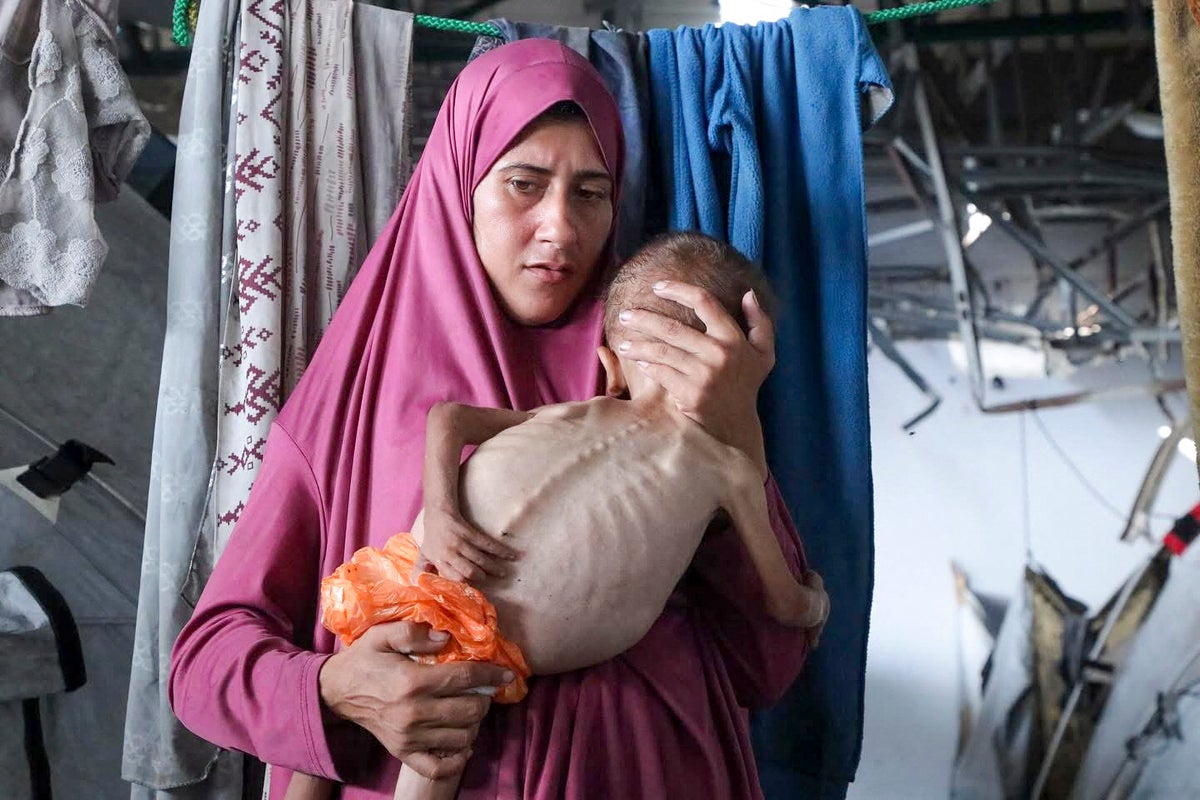
The starving children in Gaza under Israeli siege are too weak now to speak or cry, the head of Save the Children told the UN Security Council.
“The Gaza famine is here. An engineered famine. A predicted famine. A manmade famine. As we speak, children in Gaza are systematically being starved to death. This is a deliberate policy. This is starvation as a method of war in its starkest terms,” Save the Children’s international ceo Inger Ashing told the UNSC on Wednesday.
Ms Ashing’s remarks come after the world’s leading authority on food crises on Friday said more than half a million people in Gaza City are now trapped in famine after being under relentless attacks from Israeli forces who are engaged in a brutal war with Hamas.
The UN officially declared a famine in Gaza, blaming the “systematic obstruction” of aid by Israel during more than 22 months of war.
This is the first time the Integrated Food Security Phase Classification confirmed a famine in the Middle East since war broke out on 7 October in 2023 after a surprise attack by Hamas on Israel. Hamas operatives killed some 1,200 people and took about 250 hostages to Gaza.
Millions of children and women rely completely on outside aid to survive in Gaza as Israel’s military offensive and bombing has reduced the territory to rubble.
“They lie there emaciated, quite literally wasting away. Their tiny bodies overcome by hunger and disease. The medical and specialised nutrition supplies they need all but used up. Without these, malnourished children will die,” Ms Ashing said, detailing the horrific toll of Israel’s war on the territory.
She said the children in Gaza are being killed by “bombs, bullets, and now starvation”, with the attacks putting an entire generation at the risk of “being wiped out”.
More and more children have expressed the wish to be dead, she said.
“At our Child Friendly Spaces, children draw what we call ‘wishing clouds’ so that they can imagine a better future. In Gaza, children used to wish for school, or peace, or to see their friend again. Once the total siege began in March, children would increasingly tell us they wish for food, for bread. These past few weeks, more and more children have shared that they wish to be dead,” Ms Ashing said.
“One child wrote ‘I wish I was in heaven where my mother is, in heaven there is love, there is food and water’,” she said, citing a child from Gaza.
Experts have said that even if food was made widely available in the battered region, it would still take around two to three months for the regions to recover from the famine.
“I am speechless that in 2025, we are facing starvation on the planet,” said Dr Mark Manary at Washington University in St Louis, an expert on childhood malnutrition. “It’s got to be a wake-up call,” he said.
The attacks from Israel’s military have wiped out the region’s capacity to produce food inside Gaza’s territory.
“The government of Israel could end this famine tonight if it chose to end its deliberate obstruction and let humanitarians do our job. Instead, there are reports of escalations in Israeli military activity in Gaza City, more attacks on hospitals, more killing,” the Save the Children official said.
She also flagged the critical issue with airdrops which are being used by several foreign nations to send aid into Gaza.
“Children in Gaza do not need so-called creative solutions. Not air drops that deliver almost no aid while occasionally killing civilians,” Ms Ashing said.
According to the UN officials who spoke to The Independent, airdrops are always a last resort, a desperate measure.
That is because it rarely gets to those who are most in need, it can be dangerous and there are safer simpler routes via land. Those dying of starvation are too weak to grab it. Sometimes it lands in the sea. Sometimes it lands on the very people it is supposed to save, with fatal consequences.
Ms Ashing, speaking to the officials at the UNSC table, said “We told you this was coming, loudly and clearly – it has been constructed by design for two years.”
Calling it the “worst-case scenario” as there are “no more breaking points and no more alarm bells”, she said, “Every decision maker in every capital in the world – everyone in this room – has a legal and moral responsibility to act to stop these atrocities”.
Israel’s prime minister Benjamin Netanyahu has previously denied that there was starvation in Gaza. However, inside the territory, doctors and aid workers said they are seeing children arriving at the hospitals – skeletal, starving, and sometimes already dead.
Ms Ashing ended her address by asking the nations sitting at the UNSC table: “Children have reached their breaking point. Where is yours?”
